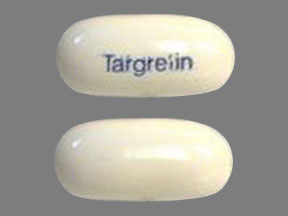Targretin Disease Interactions
There are 7 disease interactions with Targretin (bexarotene).
Bexarotene (applies to Targretin) cataracts
Moderate Potential Hazard, Moderate plausibility.
The use of bexarotene may cause new cataracts or worsening of previous cataracts. It is recommended to monitor closely for the development of any visual difficulties and to have an appropriate ophthalmologic evaluation. Exercise caution when using this agent in patients with a history of cataracts.
References
- (2001) "Product Information. Targretin (bexarotene)." Ligand Pharmaceuticals
Bexarotene (applies to Targretin) diabetes
Moderate Potential Hazard, Moderate plausibility. Applicable conditions: Diabetes Mellitus
The use of bexarotene may cause hypoglycemia in diabetic patients. It is recommended to measure baseline blood glucose levels and to keep monitoring them closely during treatment. Exercise caution when using this agent in diabetic patients.
References
- (2001) "Product Information. Targretin (bexarotene)." Ligand Pharmaceuticals
Bexarotene (applies to Targretin) hyperlipidemia
Moderate Potential Hazard, Moderate plausibility.
The use of bexarotene may cause elevations in lipids. It is recommended to monitor lipid levels closely and to obtain a fasting blood lipid reading at baseline and weekly until lipid response to the drug is established. Exercise caution when using this agent in patients with hyperlipidemia.
References
- (2001) "Product Information. Targretin (bexarotene)." Ligand Pharmaceuticals
Bexarotene (applies to Targretin) hypothyroidism
Moderate Potential Hazard, Moderate plausibility.
The use of bexarotene may cause hypothyroidism. It is recommended to consider thyroid hormone supplementation in patients with hypothyroidism, to obtain baseline thyroid function tests, and to closely monitor patients during treatment.
References
- (2001) "Product Information. Targretin (bexarotene)." Ligand Pharmaceuticals
Bexarotene (applies to Targretin) liver dysfunction
Moderate Potential Hazard, Moderate plausibility. Applicable conditions: Liver Disease
In vitro studies suggest that cytochrome P450 3A4 is the major cytochrome P450 responsible for formation of the oxidative metabolites and that the oxidative metabolites may be glucuronidated. It is recommended to monitor for signs of toxicity due to increased drug exposure if bexarotene is used in patients with hepatic impairment as these patients are expected to have a decreased drug clearance.
References
- (2001) "Product Information. Targretin (bexarotene)." Ligand Pharmaceuticals
Bexarotene (applies to Targretin) neutropenia
Moderate Potential Hazard, Moderate plausibility.
The use of bexarotene causes neutropenia. Neutropenia is reversible after dose reduction or discontinuation of treatment. Care should be exercised in patients at risk. It is recommended to obtain complete blood counts at baseline and periodically during treatment.
References
- (2001) "Product Information. Targretin (bexarotene)." Ligand Pharmaceuticals
Bexarotene (applies to Targretin) pancreatitis
Moderate Potential Hazard, Moderate plausibility.
Pancreatitis, including a fatal case, has occurred in patients receiving bexarotene. It is recommended to monitor for pancreatitis and to interrupt treatment if pancreatitis is suspected. Close monitoring is recommended in patients who have risk factors for pancreatitis, such as high alcohol consumption, uncontrolled diabetes or hyperlipidemia, and prior pancreatitis, as these patients might be at greater risk.
References
- (2001) "Product Information. Targretin (bexarotene)." Ligand Pharmaceuticals
Targretin drug interactions
There are 617 drug interactions with Targretin (bexarotene).
Targretin alcohol/food interactions
There are 2 alcohol/food interactions with Targretin (bexarotene).
More about Targretin (bexarotene)
- Targretin consumer information
- Check interactions
- Compare alternatives
- Pricing & coupons
- Reviews (2)
- Drug images
- Side effects
- Dosage information
- During pregnancy
- Generic availability
- Drug class: miscellaneous antineoplastics
- En español
Related treatment guides
Drug Interaction Classification
| Highly clinically significant. Avoid combinations; the risk of the interaction outweighs the benefit. | |
| Moderately clinically significant. Usually avoid combinations; use it only under special circumstances. | |
| Minimally clinically significant. Minimize risk; assess risk and consider an alternative drug, take steps to circumvent the interaction risk and/or institute a monitoring plan. | |
| No interaction information available. |
Further information
Always consult your healthcare provider to ensure the information displayed on this page applies to your personal circumstances.


